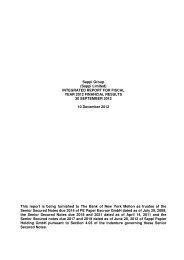2007 Annual Report - Sappi
2007 Annual Report - Sappi
2007 Annual Report - Sappi
Create successful ePaper yourself
Turn your PDF publications into a flip-book with our unique Google optimized e-Paper software.
Notes to the group annual financial statements continued<br />
for the year ended September <strong>2007</strong><br />
17. Trade and other receivables continued<br />
17.5 Off balance sheet structures<br />
Letters of credit discounting<br />
To improve the group working capital, the group discounts certain Letters of Credit with ABN AMRO Hong Kong at every<br />
financial quarter end on a non-recourse basis. This programme allows the group to obtain financing and receive payment<br />
upon shipment of goods, based on trade transaction documents. The bank will purchase a sight bill of exchange (or sight<br />
Letter of Credit) or a usance bill of exchange (or usance Letter of Credit) at a discount in line with current market rates.<br />
“Scheck-Wechsel”<br />
The Scheck-Wechsel is a financial guarantee supplied to the bank of certain trade debtors who wish to obtain a loan to<br />
finance early payment of trade receivables thereby benefiting from an early settlement discount. By signing the<br />
Scheck-Wechsel, <strong>Sappi</strong> provides a financial guarantee to the bank of the customer. This financial guarantee contract falls<br />
under the scope of IAS39 Financial Intruments.<br />
This financial guarantee contract is initially recognised at fair value. At inception the risk for <strong>Sappi</strong> having to reimburse the bank<br />
is nil because there is no evidence that the customer will not reimburse its loan to the bank. There is also no guarantee fee<br />
due by the bank and the Scheck-Wechsel is a short term instrument (maximum 90 days). Therefore the fair value is zero at<br />
inception. Subsequently the financial guarantee contract is measured at the higher of:<br />
(i) the amount determined in accordance with IAS37 ‘Provisions, Contingent Liabilities and Contingent Assets and<br />
(ii) the amount initially recognised less any cumulative amortisation.As no event of default has occurred no provision is set up<br />
and the fair value at year-end remains at zero. However according to IAS37 a contingent liability of US$20 million has been<br />
disclosed in this respect.<br />
Trade Receivables Securitisation<br />
To improve our cash flows in a cost-effective manner, we sell between 86% and 99% of our eligible trade receivables on a<br />
non-recourse basis to special purpose entities (“SPEs”) that are owned and controlled by third party financial institutions.<br />
These SPEs are funded in the commercial paper market and are not limited to transactions with us but securitise assets on<br />
behalf of their sponsors for a diverse range of unrelated parties. We have a servicing agreement with the entities acquiring<br />
our receivables, acting as agent for the collection of cash and administration of the trade receivables sold.<br />
<strong>Sappi</strong> sells the majority of its ZAR receivables to a SPE managed by Rand Merchant Bank that issues commercial paper to<br />
finance the purchase of the receivables. <strong>Sappi</strong> retains a small proportion of the credit risk attached to each underlying<br />
receivable. <strong>Sappi</strong> is responsible for the collection of all amounts that are due from the customer. The purchase price of these<br />
receivables is adjusted dependent on the timing of the payment received from the client. The rate of discounting that is<br />
charged on the receivables is JIBAR (Johannesburg Inter Bank Asking Rate) plus 93 basis points spread. This structure is<br />
currently treated as an off balance sheet arrangement. We have no obligation to repurchase any receivables which may<br />
default and do not guarantee the recoverability of any amounts over and above the first tier loss provisions. The total amount<br />
of trade receivables sold at the end of September <strong>2007</strong> amounted to US$144 million (September 2006: US$107 million).<br />
Details of the securitisation programme at the end of fiscal <strong>2007</strong> and 2006 are disclosed in the tables that follow.<br />
If this securitisation facility was to be terminated, we would discontinue further sales of trade receivables and would not incur<br />
any losses in respect of receivables previously sold in excess of our first tier loss amounts. There are a number of events which<br />
may trigger termination of the facility, amongst others, anunacceptable amount of defaults; terms and conditions of the<br />
agreements not being met; or breaches of various credit insurance ratios (not applicable to all programmes). The impact on<br />
liquidity varies according to the terms of the agreement; generally however, future trade receivables would be recorded on<br />
balance sheet until a replacement agreement was entered into.<br />
112<br />
sappi limited | 07 | annual report
















